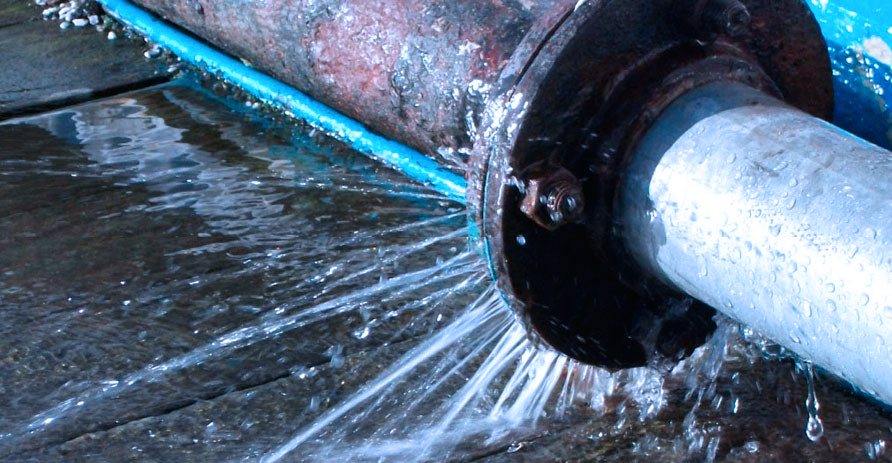Water leaks predominantly occur due to weakened pipes caused by corrosion or high pressure. Over time, corrosion can lead to the development of holes in the pipes, resulting in water leaks. This corrosion can be attributed to the water that has been flowing through the pipes for an extended period or the solid materials surrounding the pipes.
The excessive pressure within the pipeline can be a consequence of improperly closed valves, known as water hammers. This increased pressure can cause joints to become loose, leading to water leakages. Additionally, during cold weather, frozen ground can exert pressure on the pipelines, causing them to shift or create additional stress on the joints. Natural phenomena such as earthquakes or landslides can also result in water leaks.
Water leakage is a serious problem in civil construction leaking water in pipes is a very common plumbing problem, one that needs to be fixed quickly, especially if the pipes are buried, under the floor or inside walls.
Even a minimal leak, sooner or later, can cause worrying damage to the structural elements of homes or infrastructures – due to infiltration – with high repair costs. Utilizing water monitoring systems and implementing leak alerts are crucial in effectively addressing these concerns.
Which are the signs of water leakage in Buildings?
- Musty odors
- Mold and mildew
- Discoloration/ water stains on ceilings
- Warping walls
- Bucking or sagging ceilings and floors
- Unusual high-water bills
- Very low water pressure
- Accumulated water
The 10 most common causes of water leakage (structural and non-structural)
- Roof and balcony water seepage
- Clogging
- Cracks on slab or column.
- Expansion joints in the building
- Poor workmanship
- Defective pipes and changes in temperature
- Extreme weather conditions
- Poor quality of materials
- Chocked pipes
- Broken pipes
When the presence of water leakage is detected, it is imperative to take immediate action. Ignoring such an issue can lead to the spreading of the leakage throughout the entire building, resulting in the growth of mold on walls and ceilings. Ultimately, this negligence can result in significant structural damage to the building, rendering it unsafe for occupancy. Addressing the structural damage at that point becomes a costly endeavor, requiring extensive efforts to restore the building’s integrity.
‘Leakage from reservoirs is usually visible, and as the number of such structures in a network is limited, it is considered less problematic and more easily checked and recovered. Leakage from the network, on the other hand, is a different proposition, not only because the pipes extend for hundreds and thousands of kilometers and are almost all buried, but mainly because only a small proportion of leaks are visible. This is due to many factors, including the ground conditions and the location of other underground services such as sewers, in the vicinity. So finding leaks in such circumstances is quite literally a needle in a haystack problem and probably explains why leakage is so high all over the world, with values often exceeding 50% of production.’ (1)
We have two water leak sensor devices; the NI300 Water Leak Detector – Spot and the NI300 Water Leak Detector – Zone.
NI300 Water Leak Detector – Spot:
This sensor prevents water damage through instant water spot leak detection, the NI300SLD will help prevent potential water damage to properties or assets.
It includes Temperature and Humidity Monitoring. NI300SLD built-in Sensirion industrial-grade digital sensor, providing ±0.3℃ high accuracy of temperature and ±3% RH of humidity.
Combining with LoRaWAN® gateway (NI65, NI67) and IoT Cloud solution, users can manage all sensor data remotely and visually and receive alarms.
NI300 Water Leak Detector – Zone:
This sensor prevents water damage through instant water zone leak detection, the NI300ZLD will help prevent potential water damage to properties or assets.
It includes Temperature and Humidity Monitoring. NI300ZLD built-in Sensirion industrial-grade digital sensor, providing ±0.3℃ high accuracy of temperature and ±3% RH of humidity.
Combining with LoRaWAN® gateway (NI65, NI67, NI400L) and IoT Cloud solution, users can manage all sensor data remotely and visually and receive alarms.
Discover the wireless and wired solutions of Next Industries – MILANO – for the data collection of this type of application, capable of transmitting data even over long distances and in difficult environmental conditions.
To request information, write to info@nextind.eu
References:
(1) D. Rogers, Leaking Water Networks: An Economic and Environmental Disaster, Procedia Engineering, Volume 70, 2014, Pages 1421-1429, ISSN 1877-7058, https://doi.org/10.1016/j.proeng.2014.02.157.
